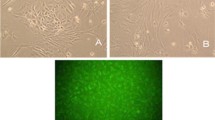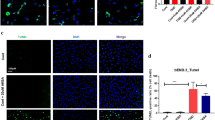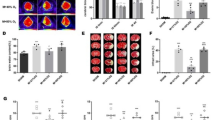Abstract
Blood-brain barrier breakdown and ROS overproduction are important events during the progression of ischemic stroke aggravating brain damage. Geraniol, a natural monoterpenoid, possesses anti-apoptotic, cytoprotective, anti-oxidant, and anti-inflammatory activities. Our study aimed to investigate the effect and underlying mechanisms of geraniol in oxygen-glucose deprivation/reoxygenation (OGD/R)-induced human brain microvascular endothelial cells (HBMECs). Apoptosis, caspase-3 activity, and cytotoxicity of HBMECs were evaluated using TUNEL, caspase-3 activity, and CCK-8 assays, respectively. The permeability of HBMECs was examined using FITC-dextran assay. Reactive oxygen species (ROS) production was measured using the fluorescent probe DCFH-DA. The protein levels of zonula occludens-1 (ZO-1), occludin, claudin-5, β-catenin, nuclear factor erythroid 2-related factor 2 (Nrf2), and heme oxygenase-1 (HO-1) were determined by western blotting. Geraniol showed no cytotoxicity in HBMECs. Geraniol and ROS scavenger N-acetylcysteine (NAC) both attenuated OGD/R-induced apoptosis and increase of caspase-3 activity and the permeability to FITC-dextran in HBMECs. Geraniol relieved OGD/R-induced ROS accumulation and decrease of expression of ZO-1, occludin, claudin-5, and β-catenin in HBMECs. Furthermore, we found that geraniol activated Nrf2/HO-1 pathway to inhibit ROS in HBMECs. In conclusion, geraniol attenuated OGD/R-induced ROS-dependent apoptosis and permeability in HBMECs through activating the Nrf2/HO-1 pathway.








Similar content being viewed by others
References
Abbott NJ, Patabendige AA, Dolman DE, Yusof SR, Begley DJ (2010) Structure and function of the blood-brain barrier. Neurobiol Dis 37(1):13–25
Alfieri A, Srivastava S, Siow RCM, Cash D, Modo M, Duchen MR et al (2013) Sulforaphane preconditioning of the Nrf2/HO-1 defense pathway protects the cerebral vasculature against blood-brain barrier disruption and neurological deficits in stroke. Free Radic Biol Med 65:1012–1022
Bai J, Lyden PD (2015) Revisiting cerebral postischemic reperfusion injury: new insights in understanding reperfusion failure, hemorrhage, and edema. Int J Stroke 10(2):143–152
Bailey TA, Kanuga N, Romero IA, Greenwood J, Luthert PJ, Cheetham ME (2004) Oxidative stress affects the junctional integrity of retinal pigment epithelial cells. Invest Ophthalmol Vis Sci 45(2):675–684
Bazan NG, Marcheselli VL, Cole-Edwards K (2005) Brain response to injury and neurodegeneration: endogenous neuroprotective signaling. Ann N Y Acad Sci 1053:137–147
Canbek M, Uyanoglu M, Canbek S, Ceyhan E, Ozen A, Durmus B et al (2017) The Effect of Geraniol on Liver Regeneration after Hepatectomy in rats. Vivo 31(2):209–213
Carden DL, Granger DN (2000) Pathophysiology of ischaemia-reperfusion injury. J Pathol 190(3):255–266
Cardoso FL, Kittel A, Veszelka S, Palmela I, Tóth A, Brites D et al (2012) Exposure to lipopolysaccharide and/or unconjugated bilirubin impair the integrity and function of brain microvascular endothelial cells. PLoS ONE 7(5):e35919
Cardozo MT, de Conti A, Ong TP, Scolastici C, Purgatto E, Horst MA et al (2011) Chemopreventive effects of β-ionone and geraniol during rat hepatocarcinogenesis promotion: distinct actions on cell proliferation, apoptosis, HMGCoA reductase, and RhoA. J Nutr Biochem 22(2):130–135
Carnesecchi S, Bras-Gonçalves R, Bradaia A, Zeisel M, Gossé F, Poupon MF et al (2004) Geraniol, a component of plant essential oils, modulates DNA synthesis and potentiates 5-fluorouracil efficacy on human colon tumor xenografts. Cancer Lett 215(1):53–59
Cassella CR, Jagoda A (2017) Ischemic stroke: advances in diagnosis and management. Emerg Med Clin North Am 35(4):911–930
Chaudhary SC, Siddiqui MS, Athar M, Alam MS (2013) Geraniol inhibits murine skin tumorigenesis by modulating COX-2 expression, Ras-ERK1/2 signaling pathway and apoptosis. J Appl Toxicol 33(8):828–837
Chen X, Liu Y, Zhu J, Lei S, Dong Y, Li L et al (2016) GSK-3β downregulates Nrf2 in cultured cortical neurons and in a rat model of cerebral ischemia-reperfusion. Sci Rep 6:20196
Chen N, Zhou Z, Li J, Li B, Feng J, He D et al (2018) 3-n-butylphthalide exerts neuroprotective effects by enhancing anti-oxidation and attenuating mitochondrial dysfunction in an in vitro model of ischemic stroke. Drug Des Devel Ther 12:4261–4271
de Carvalho KI, Bonamin F, Dos Santos RC, Périco LL, Beserra FP, de Sousa DP et al (2014) Geraniol-a flavoring agent with multifunctional effects in protecting the gastric and duodenal mucosa. Naunyn Schmiedebergs Arch Pharmacol 387(4):355–365
Ding Y, Chen M, Wang M, Wang M, Zhang T, Park J et al (2014) Neuroprotection by acetyl-11-keto-β-Boswellic acid, in ischemic brain injury involves the Nrf2/HO-1 defense pathway. Sci Rep 4:7002
El-Emam SZ, Soubh AA, Al-Mokaddem AK, Abo El-Ella DM (2020) Geraniol activates Nrf-2/HO-1 signaling pathway mediating protection against oxidative stress-induced apoptosis in hepatic ischemia-reperfusion injury. Naunyn Schmiedebergs Arch Pharmacol 393(10):1849–1858
El-Said YAM, Sallam NAA, Ain-Shoka AA, Abdel-Latif HA (2020) Geraniol ameliorates diabetic nephropathy via interference with miRNA-21/PTEN/Akt/mTORC1 pathway in rats. Naunyn Schmiedebergs Arch Pharmacol 393(12):2325–2337
Galle M, Crespo R, Kladniew BR, Villegas SM, Polo M, de Bravo MG (2014) Suppression by geraniol of the growth of A549 human lung adenocarcinoma cells and inhibition of the mevalonate pathway in culture and in vivo: potential use in cancer chemotherapy. Nutr Cancer 66(5):888–895
Gao C, Zhang CC, Yang HX, Hao YN (2020) MALAT1 protected the angiogenesis function of human brain microvascular endothelial cells (HBMECs) under oxygen glucose Deprivation/re-oxygenation (OGD/R) challenge by interacting with miR-205-5p/VEGFA pathway. Neuroscience 435:135–145
Gilgun-Sherki Y, Rosenbaum Z, Melamed E, Offen D (2002) Antioxidant therapy in acute central nervous system injury: current state. Pharmacol Rev 54(2):271–284
Hasan SK, Sultana S (2015) Geraniol attenuates 2-acetylaminofluorene induced oxidative stress, inflammation and apoptosis in the liver of Wistar rats. Toxicol Mech Methods 25(7):559–573
Hawkins BT, Davis TP (2005) The blood-brain barrier/neurovascular unit in health and disease. Pharmacol Rev 57(2):173–185
He J, Zhou D, Yan B (2020) Eriocitrin alleviates oxidative stress and inflammatory response in cerebral ischemia reperfusion rats by regulating phosphorylation levels of Nrf2/NQO-1/HO-1/NF-κB p65 proteins. Ann Transl Med 8(12):757
Hu L, Chen W, Tian F, Yuan C, Wang H, Yue H (2018) Neuroprotective role of fucoxanthin against cerebral ischemic/reperfusion injury through activation of Nrf2/HO-1 signaling. Biomed Pharmacother 106:1484–1489
Jiang S, Zhao G, Lu J, Jiang M, Wu Z, Huang Y et al (2020) Silencing of circular RNA ANRIL attenuates oxygen-glucose deprivation and reoxygenation-induced injury in human brain microvascular endothelial cells by sponging miR-622. Biol Res 53(1):27
Kaspar JW, Niture SK, Jaiswal AK (2009) Nrf2:INrf2 (Keap1) signaling in oxidative stress. Free Radic Biol Med 47(9):1304–1309
Kassner A, Merali Z (2015) Assessment of blood-brain barrier disruption in stroke. Stroke 46(11):3310–3315
Khan AQ, Khan R, Qamar W, Lateef A, Rehman MU, Tahir M et al (2013) Geraniol attenuates 12-O-tetradecanoylphorbol-13-acetate (TPA)-induced oxidative stress and inflammation in mouse skin: possible role of p38 MAP kinase and NF-κB. Exp Mol Pathol 94(3):419–429
Khoshnam SE, Winlow W, Farzaneh M, Farbood Y, Moghaddam HF (2017) Pathogenic mechanisms following ischemic stroke. Neurol Sci 38(7):1167–1186
Kim SH, Bae HC, Park EJ, Lee CR, Kim BJ, Lee S et al (2011) Geraniol inhibits prostate cancer growth by targeting cell cycle and apoptosis pathways. Biochem Biophys Res Commun 407(1):129–134
Lapergue B, Blanc R, Gory B, Labreuche J, Duhamel A, Marnat G et al (2017) Effect of Endovascular Contact Aspiration vs Stent Retriever on revascularization in patients with Acute ischemic stroke and large vessel occlusion: the ASTER Randomized Clinical Trial. JAMA 318(5):443–452
Li F, Liang J, Tang D (2018) Brahma-related gene 1 ameliorates the neuronal apoptosis and oxidative stress induced by oxygen-glucose deprivation/reoxygenation through activation of Nrf2/HO-1 signaling. Biomed Pharmacother 108:1216–1224
Lv C, Maharjan S, Wang Q, Sun Y, Han X, Wang S et al (2017) α-Lipoic acid promotes neurological recovery after ischemic stroke by activating the Nrf2/HO-1 pathway to attenuate oxidative damage. Cell Physiol Biochem 43(3):1273–1287
Marcuzzi A, Crovella S, Pontillo A (2011) Geraniol rescues inflammation in cellular and animal models of mevalonate kinase deficiency. Vivo 25(1):87–92
Mo H, Elson CE (2004) Studies of the isoprenoid-mediated inhibition of mevalonate synthesis applied to cancer chemotherapy and chemoprevention. Exp Biol Med (Maywood) 229(7):567–585
Moretti R, Pansiot J, Bettati D, Strazielle N, Ghersi-Egea JF, Damante G et al (2015) Blood-brain barrier dysfunction in disorders of the developing brain. Front Neurosci 9:40
Morita S, Furube E, Mannari T, Okuda H, Tatsumi K, Wanaka A et al (2016) Heterogeneous vascular permeability and alternative diffusion barrier in sensory circumventricular organs of adult mouse brain. Cell Tissue Res 363(2):497–511
Mozaffarian D, Benjamin EJ, Go AS, Arnett DK, Blaha MJ, Cushman M et al (2016) Heart Disease and Stroke Statistics-2016 update: a Report from the American Heart Association. Circulation 133(4):e38–360
Prakash R, Carmichael ST (2015) Blood-brain barrier breakdown and neovascularization processes after stroke and traumatic brain injury. Curr Opin Neurol 28(6):556–564
Prasad SN, Muralidhara (2014) Mitigation of acrylamide-induced behavioral deficits, oxidative impairments and neurotoxicity by oral supplements of geraniol (a monoterpene) in a rat model. Chem Biol Interact 223:27–37
Rekha KR, Inmozhi Sivakamasundari R (2018) Geraniol Protects against the Protein and oxidative stress Induced by Rotenone in an in vitro model of Parkinson’s Disease. Neurochem Res 43(10):1947–1962
Sandoval KE, Witt KA (2008) Blood-brain barrier tight junction permeability and ischemic stroke. Neurobiol Dis 32(2):200–219
Shen X, Cui X, Cui H, Jin Y, Jin W, Sun H (2019) Geraniol and lupeol inhibit growth and promote apoptosis in human hepatocarcinoma cells through the MAPK signaling pathway. 120(4):5033–5041
Shin JA, Yoon JC, Kim M, Park EM (2016) Activation of classical estrogen receptor subtypes reduces tight junction disruption of brain endothelial cells under ischemia/reperfusion injury. Free Radic Biol Med 92:78–89
Sun S, Hu F, Wu J, Zhang S (2017) Cannabidiol attenuates OGD/R-induced damage by enhancing mitochondrial bioenergetics and modulating glucose metabolism via pentose-phosphate pathway in hippocampal neurons. Redox Biol 11:577–585
Tiwari M, Kakkar P (2009) Plant derived antioxidants - Geraniol and camphene protect rat alveolar macrophages against t-BHP induced oxidative stress. Toxicol Vitro 23(2):295–301
Wang Y, Ren Q, Zhang X, Lu H, Chen J (2018) Neuroprotective Mechanisms of Calycosin Against Focal Cerebral Ischemia and Reperfusion Injury in rats. Cell Physiol Biochem 45(2):537–546
Wu Y, Wang Z, Fu X, Lin Z, Yu K (2020) Geraniol-mediated osteoarthritis improvement by down-regulating PI3K/Akt/NF-κB and MAPK signals: in vivo and in vitro studies. Int Immunopharmacol 86:106713
Yang Y, Salayandia VM, Thompson JF, Yang LY, Estrada EY, Yang Y (2015) Attenuation of acute stroke injury in rat brain by minocycline promotes blood-brain barrier remodeling and alternative microglia/macrophage activation during recovery. J Neuroinflammation 12:26
Acknowledgements
This research was supported by the Basic Scientific Research Fund Project of Huai’an Second People’s Hospital (HAEY202403).
Author information
Authors and Affiliations
Contributions
Ronggang Yang performed experiments and wrote the manuscript. Feng Yan performed experiments. Jiangyi Shen and Tiancai Wang contributed to data collection and analysis. Menglong Li and Hongzao Ni contributed to conception and supervision. All authors reviewed the manuscript.
Corresponding author
Ethics declarations
Ethical approval and consent to Participate
Not applicable.
Consent for publication
Not applicable.
Competing interests
The authors declare no competing interests.
Additional information
Publisher’s Note
Springer Nature remains neutral with regard to jurisdictional claims in published maps and institutional affiliations.
Rights and permissions
Springer Nature or its licensor (e.g. a society or other partner) holds exclusive rights to this article under a publishing agreement with the author(s) or other rightsholder(s); author self-archiving of the accepted manuscript version of this article is solely governed by the terms of such publishing agreement and applicable law.
About this article
Cite this article
Yang, R., Yan, F., Shen, J. et al. Geraniol attenuates oxygen-glucose deprivation/reoxygenation-induced ROS-dependent apoptosis and permeability of human brain microvascular endothelial cells by activating the Nrf-2/HO-1 pathway. J Bioenerg Biomembr 56, 193–204 (2024). https://doi.org/10.1007/s10863-024-10011-4
Received:
Accepted:
Published:
Issue Date:
DOI: https://doi.org/10.1007/s10863-024-10011-4




